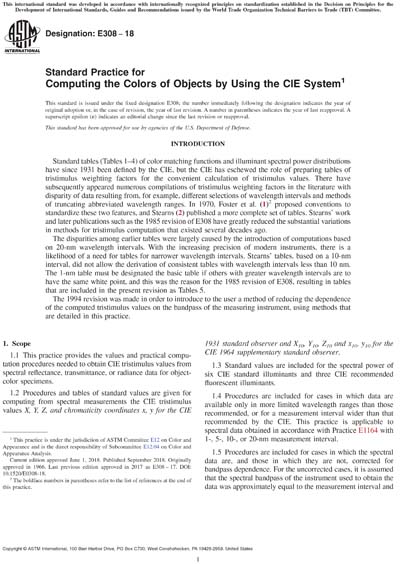Historical
ASTM E308-18
Standard Practice for Computing the Colors of Objects by Using the CIE System
1.1 This practice provides the values and practical computation procedures needed to obtain CIE tristimulus values from spectral reflectance, transmittance, or radiance data for object-color specimens.
1.2 Procedures and tables of standard values are given for computing from spectral measurements the CIE tristimulus values X, Y, Z, and chromaticity coordinates x, y for the CIE 1931 standard observer and X10, Y10, Z10 and x10. y10 for the CIE 1964 supplementary standard observer.
1.3 Standard values are included for the spectral power of six CIE standard illuminants and three CIE recommended fluorescent illuminants.
1.4 Procedures are included for cases in which data are available only in more limited wavelength ranges than those recommended, or for a measurement interval wider than that recommended by the CIE. This practice is applicable to spectral data obtained in accordance with Practice E1164 with 1-, 5-, 10-, or 20-nm measurement interval.
1.5 Procedures are included for cases in which the spectral data are, and those in which they are not, corrected for bandpass dependence. For the uncorrected cases, it is assumed that the spectral bandpass of the instrument used to obtain the data was approximately equal to the measurement interval and was triangular in shape. These choices are believed to correspond to the most widely used industrial practice.
1.6 This practice includes procedures for conversion of results to color spaces that are part of the CIE system, such as CIELAB and CIELUV (3). Equations for calculating color differences in these and other systems are given in Practice D2244.
1.7 The values stated in SI units are to be regarded as standard. No other units of measurement are included in this standard.
1.8 This standard does not purport to address all of the safety concerns, if any, associated with its use. It is the responsibility of the user of this standard to establish appropriate safety, health, and environmental practices and determine the applicability of regulatory limitations prior to use.
1.9 This international standard was developed in accordance with internationally recognized principles on standardization established in the Decision on Principles for the Development of International Standards, Guides and Recommendations issued by the World Trade Organization Technical Barriers to Trade (TBT) Committee.
Content Provider
ASTM International [astm]






